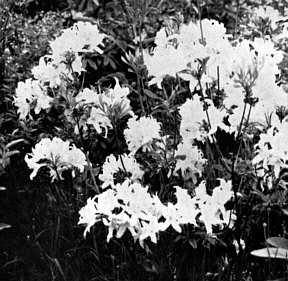QBARS - v12n4 Findings of My June Trip to the Mountains of South Carolina, North Carolina, Tennessee
Findings of my June Trip to the Mountains of South Carolina, North Carolina, Tennessee
S. D. Coleman, Fort Gaines, Georgia
I did not meet with the Dr. W. N. Fortesque group, of Hendersonville, N.C., as has been said this group sees more in one week than can be seen otherwise, as he knows all of the beauty spots, (Azaleas). And has at his home a very fine collection of the Calendulacea series.

|
|
Fig. 45
R. calendulaceum
Phetteplace photo |
In making many trips to these mountains, at different seasons, to study time of bloom, and variations, from the latter part of May to 17 of July. Which gives quite a blooming season for the one species Azalea calendulaceum , (Fig. 45). I find the late type after comparing both flower and foliage, to find very little difference, in other words they compare favorably. Some think the mixing has been pretty heavy. Of course in the beginning Azalea calendulaceum , could have come from hybrid origin, and am sure that Azalea bakeri comes in contact with this plant, but they have done pretty well holding their own as both species are beautiful, and at Soco Gap, west of Maggie, N.C., is one of the beauty spots of the Mountains. I believe on Peach Tree Mountain is a continuation of this same series, of the late A. calendulaceum . I went real late to see the foliage, of both early and late types.
Something else of interest was finding Azalea montana growing and blooming, with the type plant Azalea viscosa , also with Azalea arborescens . This possibly is where we get so many variations of A. viscosa . It is also strange that we do not find the Viscose series with the yellow or orange blotch on upper lobe. I did find larger flower than usual of Azalea viscosa .
I did find again the little plant of the R. carolinianum series with the little purple flowers the color of violet, late bloomer, possibly a month later than the last of this series, does not have much tube, and seemingly a heavy bloomer, growing on very steep Mountain side. My first small seedlings of these plants seem to bunch out and grow very slow, only had three to live. Rhododendron carolinianum collected at the same time, have grown off nicely.
Rhododendron carolinianum is more of a mountain plant, R. minus is more at home along Chattahoochee River, of Georgia and Alabama. R. chapmani , is the North Florida plant. Bringing them together on "Coleman's Native Azalea Trail" I have some plants that bloom at the same time. Selected plants in different species will bloom at different times. The tube on R. chapmani , is the longer, R. minus next and R. carolinianum , the shortest and the little plant just found has pretty near no tube.
In planting three to five plants of each species of this group in a setting I have, as well as a number of other lovers of these plants, come to the conclusion that the R. minus is the show plant of the three, to date. There is a plant further north called R. minus which I think is one of the variations of R. carolinianum species. There are two types of the white R. carolinianum in the mountains. One is pretty near deciduous at this place.
On the mountain southwest of Hendersonville, near the head of Green River, you find, Azalea calendulaceum with pink tubes. I am sure pink flowers could he found, there, natural hybridization as I see it has taken place in the Azalea speciosa species than any I have seen. Yet you find more types and colors in flowers. And they are beautiful.
